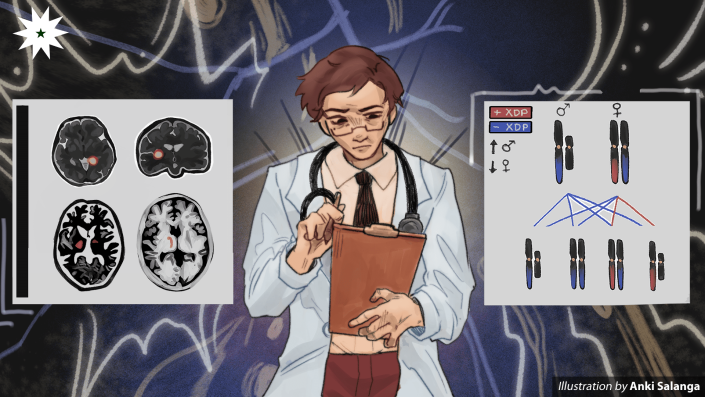
X-linked parkinsonism dystonia (XDP) is a movement disorder characterized by abnormal muscle movement, twisting, and posturing. More commonly known to Filipinos as “lubag”, patients with the genetic condition often first experience dystonia before parkinsonism also sets in—the former being a movement disorder causing the involuntary contraction of muscles and the latter being a neurological disorder causing tremors and body stiffness.
“XDP is attributed as a Filipino disease to date, as it has not yet been seen in other ethnic groups”, explains Dr. Raymond Rosales, a professor at the Medical Faculty of the University of Santo Tomas. “Ten years ago, we saw that about 0.3 percent or thousands of the [Philippine] population will have [the] disease,” he notes. The disease is most prevalent in Panay Island, specifically the province of Capiz, where it is estimated that 23 out of 10,000 individuals have the disease. Moreover, XDP is an X-linked disease that only manifests in males, while females are merely asymptomatic carriers of the gene.
Progression through time
According to Rosales, the genetic mutation causing the disease is linked to an insertion of a SINE-VNTR-Alu-type retrotransposon, which is a genetic component found in humans that decreases the expression of the gene that functions to regulate other critical genes found in the brain, known as the TAF1 gene. Through this, there is an abnormal pattern of a chemical reaction responsible for biological functions in the body, which negatively affects the body’s performance such as in muscle movement and posture.
The professor states that a patient with XDP may experience initial dystonia in one particular body region. For example, some patients may experience cervical dystonia in their neck, ocular dystonia in the eyes, or foot or hand dystonia in their limbs. Within a span of two to five years, this can further spread throughout the body and become generalized dystonia. At this point, the dystonia would have now spread to the trunk and other body extremities that were previously unaffected.
As the disease progresses, parkinsonism will begin to set in within the patient. XDP patients experience rigidity, tremors, and bradykinesia—the slowness of movement. “So, therefore, they now have a mixed movement disorder,” notes Rosales.
Combating the disease
As a genetic disease that remains to be further elucidated, XDP still has no definite cure. Nonetheless, Rosales highlights three modes of treatment that are currently being used to aid XDP patients. Among the three, symptomatic treatment is the most feasible option for XDP patients as it mostly involves the use of muscle-relaxing agents, such as benzodiazepine and cyclobenzaprine. While these agents soothe the affected muscle areas, it does not directly address the root cause of XDP. They also come with a variety of adverse side effects such as sedation.
The second treatment type is the use of botulinum neurotoxin, which is a medication used for spastic disorders and dystonia. It becomes a form of focal therapy to provide localized treatment to affected areas, injected into muscles to relax and reduce excessive contractions.
The last mode of treatment mentioned by Rosales is Deep Brain Stimulation (DBS). This method involves the use of controlled electrical currents to stimulate the brain’s globus pallidus internus, which controls movement. By implanting electrical impulses in this area through surgery, the uncontrollable contractions caused by XDP are regulated. However, while stimulations do function as a long-term mode of management, Rosales says DBS is very costly, especially with its growing popularity as a treatment.
For detecting asymptomatic cases, on the other hand, Rosales also suggests that people proactively take note of their genetic ancestry to detect if they are susceptible to getting XDP. “Look for siblings and cousins…from the maternal side, so we can detect if they are carrying the abnormal TAF1 gene,” he underlines. Through this, one can obtain early treatment to avoid the extreme progression of the disease.
Moving forward to light
Expressing hope for current research being conducted for targeted genetic treatments, Rosales shares that “more research is now being made from the genetic aspects of the approach to the treatment and how it affects the area.” He also explains how samples from patients in the country are sent to Germany for further study. Hopefully, with the new medical research being done, a brighter path to recovery will be available for XDP patients.
